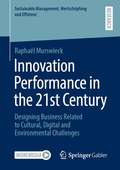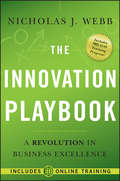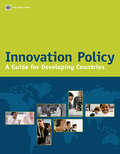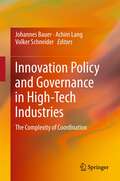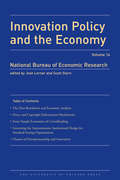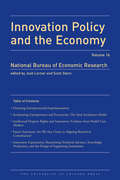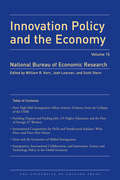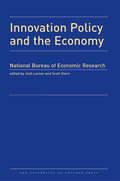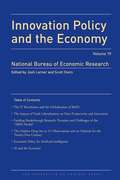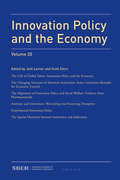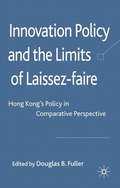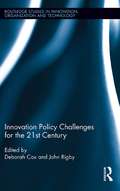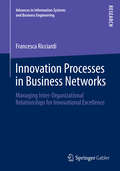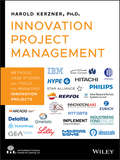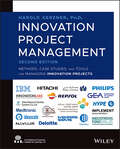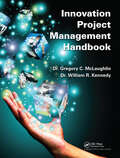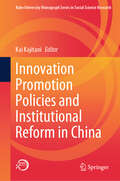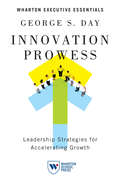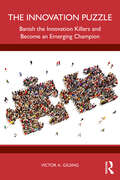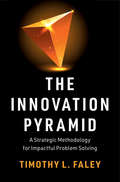- Table View
- List View
Innovation Performance in the 21st Century: Designing Business Related to Cultural, Digital and Environmental Challenges (Sustainable Management, Wertschöpfung und Effizienz)
by Raphaël MurswieckPerformant business models in the 21st century are characterized by the intelligent integration of soft, human-based aspects on the one hand and technology-based opportunities on the other hand to foster not only economic but also environmental results. Based on a mixed research approach, the presented business innovation model (BIM) shows a practical way in how organizations can lever their cultural human-based potential to increase and manage their innovation performance. The studies reveal cultural determinants supporting innovation performance at the beginning of the process respecting the value aspect by adopting digital technologies and deploying environmentally friendly circular principles within business models to develop more sustainable products and services.
The Innovation Playbook, + web site
by Webb Nicholas J. Chris ThoenA complete roadmap to a revolution in business excellence founded on innovation Author and successful innovator Nicholas Webb believes we need a revolution in business excellence founded on innovation. In The Innovation Playbook, you will learn why innovations fail, the five rules of customer connectivity, the power of "real open" innovation and customer co-creation, the secret formula for reducing product and market risk, the magic of Future-casting, and so much more. Includes an abundance of anecdotes and examples of successful-and unsuccessful-innovation Shares the 56 ways in which innovations fail Learn the success secrets of "Innovation Superstars" Reduce innovation failure and build speed to market Includes online training a ($150. 00 value) that will help you put the theory into practice, The Innovation Playbook will prepare you to get your CIS Certification, as well as to implement a successful innovation culture in corporate life.
Innovation Policy: A Guide for Developing Countries
by World BankInnovation in all its forms, particularly technological innovation, has become a crucial driver of growth, enhancing competitiveness and increasing social well-being in all economies of the world. In a broad and diversified sense, innovation comprises not only the creation of new technology, but even more important, it includes the diffusion and use of products, processes, and practices that are new in a given country context. Inspired by the experiences of both industrial and developing countries, this book focuses on the needs and issues of the latter. Aiming at creating a climate in which innovative initiatives can multiply and flourish, innovation policy, by its very nature, touches such diverse policy areas as education and training, skills development, science and research, the business environment, information and communication technology, and other infrastructure. Adopting this interdepartmental perspective, this guidebook presents, in detail, the actions required in such a varied set of policy areas that typically work in silos. It offers also insights on the implementation of innovation policies in the difficult contexts of low and medium income countries characterized by the resistance of innovation systems to significant improvements. 'Innovation Policy: A Guide for Developing Countries' is geared toward the policy-making community. This large group includes not only those who deal directly with technology, industry, science, and education but also those in charge of finance and economics. Indeed, it includes the top government leadership, which plays a crucial role in successful innovation policies.
Innovation Policy and Governance in High-Tech Industries: The Complexity of Coordination
by Achim Lang Volker Schneider Johannes BauerThe book examines the conditions for successful high-technology policy from theoretical and empirical perspectives. It enhances the predominant national systems of innovation approach to innovation policy with concepts based on new developments in the governance of complex systems and processes. The conceptual framework of complex networks and systems is used to examine national policy approaches in countries that have created environments conducive to high-technology industries as well as individual high-technology sectors, such as biotechnology, alternative energy, and aerospace. Theoretical and empirical contributions are synthesised into lessons for high-tech policy and further research.
Innovation Policy and the Economy 2013: Volume 14
by Josh Lerner Scott SternAppreciation of the importance of innovation to the economy has increased over the past decade. There is an active debate regarding the implications of technological change for economic policy and the appropriate policies and programs regarding research, innovation, and the commercialization of new technology. This debate has only intensified as policymakers focus on new sources of innovation and growth in light of the recent economic downturn and the associated focus on enhancing employment and growth. Four of the five papers in this year's volume highlight the increasing role of the Internet and digitization in our understanding of the changing nature of innovation and entrepreneurship, and the impact of innovation policy. The first offers an overview of the impact of "Big Data" on the ability to conduct novel types of measurement and research in economics and related fields. The second highlights the increasingly sophisticated and creative research designs that have been used to evaluate the interplay between piracy, the availability of legitimate digital channels, and the impact of anti-piracy enforcement efforts. The third paper provides an overview of the rapidly emerging area of crowdfunding. The fourth addresses the underpinnings of much of the digital economy by focusing on the institutional logic of standard-setting organizations and the conditions that allow standard-setting bodies to function and achieve their objectives. The final paper focuses on the interplay between geographic clusters, entrepreneurship, and innovation.
Innovation Policy and the Economy 2013: Volume 14 (National Bureau of Economic Research Innovation Policy and the Economy #14)
by The University of Chicago PressAppreciation of the importance of innovation to the economy has increased over the past decade. There is an active debate regarding the implications of technological change for economic policy and the appropriate policies and programs regarding research, innovation, and the commercialization of new technology. This debate has only intensified as policymakers focus on new sources of innovation and growth in light of the recent economic downturn and the associated focus on enhancing employment and growth. Four of the five papers in this year’s volume highlight the increasing role of the Internet and digitization in our understanding of the changing nature of innovation and entrepreneurship, and the impact of innovation policy. The first offers an overview of the impact of “Big Data” on the ability to conduct novel types of measurement and research in economics and related fields. The second highlights the increasingly sophisticated and creative research designs that have been used to evaluate the interplay between piracy, the availability of legitimate digital channels, and the impact of anti-piracy enforcement efforts. The third paper provides an overview of the rapidly emerging area of crowdfunding. The fourth addresses the underpinnings of much of the digital economy by focusing on the institutional logic of standard-setting organizations and the conditions that allow standard-setting bodies to function and achieve their objectives. The final paper focuses on the interplay between geographic clusters, entrepreneurship, and innovation.
Innovation Policy and the Economy 2014: Volume 15
by Josh Lerner William R. Kerr Scott SternThe fifteenth volume of Innovation Policy and the Economy is the first to focus on a single theme: high-skilled immigration to the United States. The first paper is the product of a long-term research effort on the impact of immigration to the United States of Russian mathematicians beginning around 1990 as the Soviet Union collapsed. The second paper describes how obtaining a degree from a US undergraduate university can open an important pathway for immigrants to participate in the US labor market in IT occupations. The third paper considers the changing nature of postdoctoral positions in science departments, which are disproportionately held by immigrant researchers. The fourth paper considers the role of US firms in high-skilled immigration. The last paper describes how strong growth in global scientific and technological knowledge production has reduced the share of world scientific activity in the United States, increased the immigrant proportion of scientists and engineers at US universities and firms, and fostered cross-border collaborations for US scientists.
Innovation Policy and the Economy 2014: Volume 15 (National Bureau of Economic Research Innovation Policy and the Economy)
by The University of Chicago PressThe fifteenth volume of Innovation Policy and the Economy is the first to focus on a single theme: high-skilled immigration to the United States. The first paper is the product of a long-term research effort on the impact of immigration to the United States of Russian mathematicians beginning around 1990 as the Soviet Union collapsed. The second paper describes how obtaining a degree from a US undergraduate university can open an important pathway for immigrants to participate in the US labor market in IT occupations. The third paper considers the changing nature of postdoctoral positions in science departments, which are disproportionately held by immigrant researchers. The fourth paper considers the role of US firms in high-skilled immigration. The last paper describes how strong growth in global scientific and technological knowledge production has reduced the share of world scientific activity in the United States, increased the immigrant proportion of scientists and engineers at US universities and firms, and fostered cross-border collaborations for US scientists.
Innovation Policy and the Economy 2015: Volume 16 (National Bureau of Economic Research Innovation Policy and the Economy)
by The University of Chicago PressThe papers in the sixteenth volume of the National Bureau of Economic Research’s Innovation Policy and the Economy offer insights into the changing landscape of innovation by highlighting recent developments in the financing of innovation and entrepreneurship and in the economics of innovation and intellectual property. The first chapter, by Ramana Nanda and Matthew Rhodes-Kropf, explores the process of experimentation in the context of financing of technology start-ups by venture capitalists. The second, by Yael Hochberg, also analyzes the role of entrepreneurial experimentation by systematically examining the rise of start-up accelerators. The third chapter, by Heidi Williams, studies the relationship between the strength of intellectual property rights and innovation. The fourth paper, by Fiona Scott Morton and Carl Shapiro discusses recent changes to the patent system and whether they align the rewards from intellectual property with the marginal contributions made by innovators and other stakeholders. The final chapter, by Karim Lakhani and Kevin Boudreau, focuses on the potential use of field innovation experiments and contests to inform innovation policy and management. Together, these essays continue to highlight the importance of economic theory and empirical analysis in innovation policy research.
Innovation Policy and the Economy, 2016: Volume 17 (National Bureau of Economic Research Innovation Policy and the Economy #17)
by The University of Chicago PressThe seventeenth volume of the National Bureau of Economic Research’s Innovation Policy and the Economy provides an accessible forum for bringing the work of leading academic researchers to an audience of policymakers and those interested in the interaction between public policy and innovation. In the first chapter, Joel Waldfogel discusses how reduced costs of production have resulted in a “Golden Age of Television,” arguing that this development has gone underappreciated. The second chapter, by Marc Rysman and Scott Schuh, discusses the prospects for innovation in payment systems, including mobile payments, faster payment systems, and digital currencies. In the third chapter, Catherine Tucker and Amalia Miller analyze the consequences of patient data becoming virtually costless to store, share, and individualize, showing how data management and privacy issues have become a key factor in health policy. The fourth chapter, by Michael Luca, examines how online marketplaces have proliferated over the past decade, evolving far beyond the pioneers such as eBay and Amazon. In the fifth chapter, Tim Bresnahan and Pai-Ling Yin characterize information and communication technologies in the workplace, addressing how wages vary with increasing demand for smart managers and professionals, and workers with organizational participation skills.
Innovation Policy and the Economy, 2017: Volume 18 (National Bureau of Economic Research Innovation Policy and the Economy #18)
by The University of Chicago PressThe eighteenth annual volume of the National Bureau of Economic Research’s Innovation Policy and the Economy focuses on research that explores the interplay between new technologies and organizational structures, such as networks and corporations. In the first chapter, Glenn Ellison and Sara Fisher Ellison explore how consumer search in a technology-mediated marketplace can affect the incentives for firms to engage in price obfuscation. In the second chapter, Aaron Chatterji focuses on the role of innovation in American primary and secondary education (K–12), emphasizing recent evidence on the efficacy of classroom technologies. The third chapter, by economic sociologist Olav Sorenson, considers how information, influence, and resources flow through innovation networks. The last two chapters focus on how corporate organizational structures influence innovation and dynamism. In the fourth chapter, Andreas Nilsson and David Robinson develop a synthetic framework for understanding the emergence and choices of social entrepreneurs and socially responsible firms. In the fifth chapter, Steven Kaplan argues that there is little empirical evidence to support the common claim that investor pressure for short-term financial results leads U.S. companies to systematically underinvest in long-term capital expenditures and R&D.
Innovation Policy and the Economy, 2018: Volume 19 (National Bureau of Economic Research Innovation Policy and the Economy #19)
by The University of Chicago PressThis volume highlights the interaction between public policy and innovation. The first chapter documents the dramatic globalization of R&D and how this development has affected the efforts of U.S. multinationals to operate on the global technology frontier. The next chapter synthesizes research on the impact of trade shocks on innovation and explains how these shocks’ effects depend on the firms, industries, and countries affected. The third chapter examines the Advanced Research Projects Agency (ARPA) model of research management—an approach to funding and managing high-risk R&D—and offers a method for diagnosing which research efforts are “ARPA-able.” Next is a study of the Orphan Drug Act and the key changes in the U.S. healthcare landscape and in drug discovery and development since its passage in 1983. The next two chapters focus on artificial intelligence (AI). One describes how AI diffuses through the economy and discusses implications for economic inequality, antitrust, and intellectual property. The other investigates issues surrounding firm competition and labor force participation, such as data portability and a Universal Basic Income, and evaluates ways to address these issues.
Innovation Policy and the Economy, 2019: Volume 20 (National Bureau of Economic Research Innovation Policy and the Economy)
by The University of Chicago PressThe chapters in this twentieth volume of Innovation Policy and the Economy present research on the interactions among public policy, the innovation process, and the economy. One explores changes in the ability of the U.S. to attract talented foreign workers and the role of sponsoring institutions in shaping immigration policy. Another explains how the division of innovative labor between research universities and corporate labs affected productivity growth and the transformation of knowledge into new products and processes. A third reviews different innovation policies and their performance in the pharmaceutical sector. Next is a chapter on the effects of competition policy on innovation, “creative destruction,” and economic growth. A fifth chapter studies how experimental policy design can be a cost-effective way to attain program goals. The last chapter examines geographic disparities in innovation, joblessness, and technological dynamism and studies how reallocation of grants and geographically targeted entrepreneurship policy could affect labor supply and welfare.
Innovation Policy and the Limits of Laissez-faire
by Douglas B. FullerHong Kong's laissez-faire tradition has crippled attempts to transform it into a more knowledge-intensive economy and this is a lesson with wide applicability. Many emerging economies face innovation bottlenecks, but even some more advanced economies face similar constraints and may benefit from the lessons of its negative example.
Innovation Policy Challenges for the 21st Century (Routledge Studies in Innovation, Organizations and Technology)
by Deborah Cox John RigbyAs the economies of western countries move from primarily resource-based to knowledge-based, and trade liberalization limits what governments can do through direct action, the landscape of innovation is changing and policymakers must react accordingly. This exciting new book examines the challenges that policy makers face in responding to a new environment. The book addresses how governments are now seeking to drive innovation through new forms of R&D policies, through public procurement, skills development, entrepreneurship and innovation culture to name but a few of the approaches. Innovation Policy Challenges for the 21st Century explores these and other contemporary issues in innovation, reviewing the state of the art literature and consolidating current thinking at the frontiers of innovation. The volume debates and presents scattered and anonymous material in a coherent way, with a particular focus is on ‘hot topics’ in the field of innovation studies that have been previously under-researched. The book is divided into four key themes: government as a key actor in the innovation process, entrepreneurs as innovators, skills and competences required to maintain and improve innovation performance in Europe and finally, the wider context in which innovation policy develops.
Innovation Processes
by Robert S. Kaplan David P. NortonSustaining competitive advantage requires that organizations continually innovate to create new products, services, and processes. Exceptional innovation capabilities determine industry leaders. This chapter identifies high-level objectives and associated measures for four innovation processes, including identifying opportunities for new products and services, and bringing new products and services to market. A case study follows the chapter.
Innovation Processes in Agro-Ecological Transitions in Developing Countries
by Ludovic Temple Eveline M. Compaore SawadogoThis book investigates the interactions between different shifts in innovation models. It underlines ecological conditions and production intensification in the agriculture sector. In total six innovation processes were analyzed in different countries such as Burkina Faso, Cameroon, Haiti, Madagascar and Senegal. The similarities between these case studies are that they all demonstrate that sustainable and sufficient network between actors of the innovation are particularly useful for the development of agricultural innovation systems. The different papers demonstrate that there is a need for more commitment of public policy in innovation processes.
Innovation Processes in Business Networks
by Francesca RicciardiIn today's networked economy, each organization is more and more shaped by the system of its long-term business interactions. Innovation processes cannot be successfully designed and managed unless the complex influences of business networking on innovation processes and innovation-related performances are clearly understood. But extant theories on business networks are fragmented, and each of them, taken singularly, provides only partial or poor understanding of the impacts of business networking on innovation performances. Based on qualitative research on three exemplary worst practices and on expert panel discussion and validation, Francesca Ricciardi develops novel quantitative models in this theory-building work to explain innovation performances in different interorganizational networks.
Innovation Project Management: Methods, Case Studies, and Tools for Managing Innovation Projects
by Harold KerznerActionable tools, processes and metrics for successfully managing innovation projects Conventional project management methods are oftentimes insufficient for managing innovation projects. Innovation is lost under the pre-determined scope and forecasted environments of traditional project management. There is tremendous pressure on organizations to innovate, and the project managers responsible for managing these innovation projects do not have the training or tools to do their jobs effectively. Innovation Project Management provides the tools, insights, and metrics needed to successfully manage innovation projects—helping readers identify problems in their organization, conceive elegant solutions, and, when necessary, promote changes to their organizational culture. There are several kinds of innovation—ranging from incremental changes to existing products to wholly original processes that emerge from market-disrupting new technology—that possess different characteristics and often require different tools. Best-selling author and project management expert Harold Kerzner integrates innovation, project management, and strategic planning to offer students and practicing professionals the essential tools and processes to analyze innovation from all sides. Innovation Project Management deconstructs traditional project management methods and explains why and how innovation projects should be managed differently. This invaluable resource: Provides practical advice and actionable tools for effectively managing innovation projects Offers value-based project management metrics and guidance on how to establish a metrics management program Shares exclusive insights from project managers at world-class organizations such as Airbus, Boeing, Hitachi, IBM, and Siemens on how they manage innovation projects Explores a variety of types of innovation including co-creation, value-driven, agile, open versus closed, and more Instructors have access to PowerPoint lecture slides by chapter through the book’s companion website Innovation Project Management: Methods, Case Studies, and Tools for Managing Innovation Projects is an essential text for professional project managers, corporate managers, innovation team members, as well as students in project management, innovation and entrepreneurship programs.
Innovation Project Management: Methods, Case Studies, and Tools for Managing Innovation Projects
by Harold KerznerINNOVATION PROJECT MANAGEMENT ACTIONABLE TOOLS, PROCESSES, AND METRICS FOR SUCCESSFULLY MANAGING INNOVATION PROJECTS, WITH EXCLUSIVE INSIGHTS FROM WORLD-CLASS ORGANIZATIONS AROUND THE WORLD The newly revised Second Edition of Innovation Project Management offers students and practicing professionals the tools, processes, and metrics needed to successfully manage innovation projects, providing value-based innovation project management metrics as well as guidance for how to establish a metrics management program. The highly qualified author analyzes innovation from all sides; through this approach, Innovation Project Management breaks down traditional project management methods and explains why and how innovation projects should be managed differently. The Second Edition includes exclusive insights from world-class organizations such as IBM, Hitachi, Repsol, Philips, Deloitte, IdeaScale, KAUST, and more. It includes six all new case studies, featuring a dive into brand management innovation from Lego. Each case study contains questions for discussion, and instructors have access to an Instructor’s Manual via the book’s companion website. Specific ideas discussed in Innovation Project Management include: Continuous versus discontinuous innovation, incremental versus radical innovation, understanding innovation differences, and incremental innovation versus new product development Identifying core competencies using SWOT analysis and nondisclosure agreements, secrecy agreements, and confidentiality agreements Implications and issues for project managers and innovation personnel, active listening, pitching the innovation, and cognitive biases Measuring intangible assets, customer/stakeholder impact on value metrics, customer value management programs, and the relationship between project management and value With its highly detailed and comprehensive coverage of the field, and with case studies from leading companies to show how concepts are applied in real-world situations, Innovation Project Management is a must-have title for practicing project managers, as well as students in project management, innovation, and entrepreneurship programs.
Innovation Project Management Handbook
by Dr.Gregory C. McLaughlin Dr. William KennedyInnovation Project Management Handbook provides organizational leaders and decision-makers with a cadre of agile, disciplined, and transformational tools and processes for improving innovation opportunity outcomes and achieving sustained innovation project success. The authors introduce new tools and processes developed over their decades of work i
Innovation Promotion Policies and Institutional Reform in China (Kobe University Monograph Series in Social Science Research)
by Kai KajitaniThis book focuses on the political economy behind innovation in China's new industrial sectors, particularly the effects of policies and government regulation in the absence of the rule of law. In its analysis, the book aims to elucidate the mechanisms that generate innovation from multiple perspectives while utilizing insights from political science and law. The analysis in this book focuses on the following three points. First, by examining Guizhou Province's Big-data industry promotion policy, "import substitution digitization" policy, and government intellectual property strategy, we seek to empirically clarify the extent to which Chinese government industrial policy has stimulated innovation. Next, we examine in detail the issues surrounding the "rule of law" in China regarding introducing anti-monopoly laws for digital platform companies and developing the intellectual property court system. Third, it focuses on the role played by local governments in industrial policy, including the impact of industrial guidance funds on the efficiency of the regional financial sector and the impact of local bond issuance on the effectiveness of resource allocation among regions.
Innovation Prowess: Leadership Strategies for Accelerating Growth (Wharton Executive Essentials)
by George S. DayA framework for achieving superior rates of organic growthAchieving superior growth through innovation is a top strategic priority for all companies. Yet most management teams struggle to reach their firm's ambitious growth targets and suffer slow growth. What distinguishes these growth laggards from growth leaders like IBM, Nike, LEGO, American Express, Amazon, and Samsung that realize their full potential for growth?Wharton professor George S. Day shows that growth leaders use their innovation prowess to accelerate their growth at a faster rate. In this essential guide, Day reveals how to build this prowess by combining discipline in growth-seeking activities with an organizational ability to innovate. Day shows managers how to set a growth strategy that is realistic while still stretching the organization; search for the best growth opportunities along the full spectrum of 14 growth pathways; aim their growth-seeking activities toward the creation of new customer value; learn to profit from the uncertainty of innovation by successfully assessing and containing risk; build the organizational muscle to implement an ambitious growth strategy; and move faster from ideas to impact.With the strategies, processes, and methods discussed in Innovation Prowess, leaders can build a tested and comprehensive strategy for driving organic growth year after year.The Wharton Executive Essentials SeriesThe Wharton Executive Essentials series from Wharton Digital Press brings the ideas of the Wharton School's thought leaders to you wherever you are. Inspired by Wharton's Executive Education program, each book is authored by globally renowned faculty and offers a quick-reading, penetrating, and comprehensive summary of the knowledge leaders need to excel in today's competitive business environment and capture tomorrow's opportunities.
The Innovation Puzzle: Banish the Innovation Killers and Become an Emerging Champion
by Victor GilsingBeyond a generic innovation toolkit, this book dissects the hidden biases and behavioral traps that too often doom innovation within companies to failure. It takes the reader on a journey to learn how to banish these innovation killers for good and turn their company into an innovation champion. In The Innovation Puzzle, Professor Victor A. Gilsing reveals that in most cases, these outcomes cannot be blamed on a lack of funding or a failure to follow innovation gurus’ playbooks. Often, the real problem is that companies unwittingly build hidden barriers to innovation within themselves. From the systems they use to structure and monitor their business units to their hiring and promotion policies, not to mention their executives’ leadership styles. Many of these processes and practices underpinning their core business activities end up depriving innovation of the time, space, vision, talents, and perseverance it needs to succeed. Building on this insight, The Innovation Puzzle helps readers identify and remove these barriers within their own firms. Rather than one-size-fits-all solutions, this volume offers instructive real-world examples. It provides practical, visually rich, and easy-to-apply tools that guide readers toward the measures that will transform their company from a follower into a leader in innovation. Perfect for executives and board members as well as for innovation talents and their managers, The Innovation Puzzle is the key that will unlock the expertise, innovation ambitions, and inspiration your firm needs to realize its true innovation potential and become an innovation champion.
The Innovation Pyramid: A Strategic Methodology for Impactful Problem Solving
by Timothy L. FaleyThe Innovation Pyramid is a learnable, repeatable, non-linear, knowledge-based innovation methodology. While traditional books on innovation focus on either assembling an innovation team with the right combination of innate abilities or developing a creativity skillset, the Innovation Pyramid instead trains readers to produce serial innovations successfully. The original method segments innovation into four distinct yet interrelated stages: (1) identification of the root problem, (2) formulation of a solution, (3) development of an execution plan and (4) implementation. At all stages, it considers the perspectives of both the innovator and the adopter, in order to increase the likelihood that innovations will achieve significant impact. Section I of the book describes the over-arching method of innovating. Section II details the creativity-based process for implementing the Innovation Pyramid methodology. Finally, the book's appendices include advanced techniques to enhance the utility of the Innovation Pyramid method.
